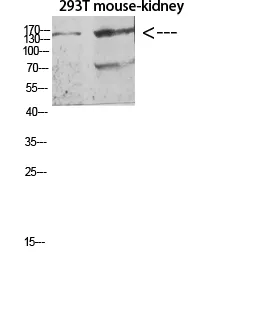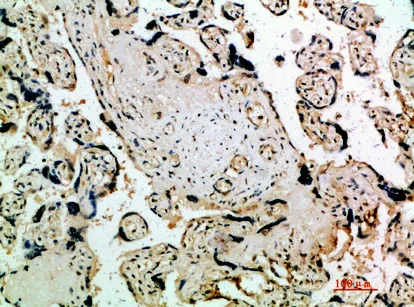

Size:50μL Price:$118
Size:100μL Price:$220
Size:200μL Price:$380
Application:WB,IHC,ICC/IF,ELISA
Reactivity:Human,Mouse,Rat
Conjugate:Unconjugated
Optional conjugates: Biotin, FITC (free of charge). See other 26 conjugates.
Gene Name:FLT4 VEGFR3
Summary
| Production Name | Flt-4 Rabbit Polyclonal Antibody |
| Description | Rabbit polyclonal Antibody |
| Host | Rabbit |
| Application | WB,IHC,ICC/IF,ELISA |
| Reactivity | Human,Mouse,Rat |
Performance
| Conjugation | Unconjugated |
| Modification | Unmodified |
| Isotype | IgG |
| Clonality | Polyclonal |
| Form | Liquid |
| Storage | Store at 4°C short term. Aliquot and store at -20°C long term. Avoid freeze/thaw cycles. |
| Buffer | Liquid in PBS containing 50% glycerol, 0.5% protective protein and 0.02% New type preservative N. |
| Purification | Affinity purification |
Immunogen
| Gene Name | FLT4 VEGFR3 |
| Alternative Names | Vascular endothelial growth factor receptor 3 (VEGFR-3;EC 2.7.10.1;Fms-like tyrosine kinase 4;FLT-4;Tyrosine-protein kinase receptor FLT4) |
| Gene ID | 2324 |
| SwissProt ID | P35916 |
Application
| Dilution Ratio | WB 1:500-1:2000,IHC 1:50-1:200,ICC/IF 1:50-1:200,ELISA 1:10000-1:20000 |
| Molecular Weight | 170kDa |
Background
This gene encodes a tyrosine kinase receptor for vascular endothelial growth factors C and D. The protein is thought to be involved in lymphangiogenesis and maintenance of the lymphatic endothelium. Mutations in this gene cause hereditary lymphedema type IA. [provided by RefSeq, Jul 2008],catalytic activity:ATP + a [protein]-L-tyrosine = ADP + a [protein]-L-tyrosine phosphate.,disease:Defects in FLT4 are found in juvenile hemangioma. Juvenile hemangiomas are the most common tumors of infancy, occurring as many as 10% of all births. These benign vascular lesions enlarge rapidly during the first year of life by hyperplasia of endothelial cells and attendant pericytes, and then spontaneously involute over a period of years, leaving loose fibrofatty tissue.,disease:Defects in FLT4 are the cause of lymphedema hereditary type 1 (LYH1A) [MIM:153100]; also known as Nonne-Milroy lymphedema or Milroy disease. Hereditary lymphedema is a chronic disabling condition which results in swelling of the extremities due to altered lymphatic flow. Patients with lymphedema suffer from recurrent local infections and physical impairment.,function:Receptor for VEGFC. Has a tyrosine-protein kinase activity.,online information:FLT4 entry,similarity:Belongs to the protein kinase superfamily. Tyr protein kinase family.,similarity:Belongs to the protein kinase superfamily. Tyr protein kinase family. CSF-1/PDGF receptor subfamily.,similarity:Contains 1 protein kinase domain.,similarity:Contains 7 Ig-like C2-type (immunoglobulin-like) domains.,tissue specificity:Placenta, lung, heart, and kidney, does not seem to be expressed in pancreas and brain.,
Research Area
Cytokine-cytokine receptor interaction;Focal adhesion;
